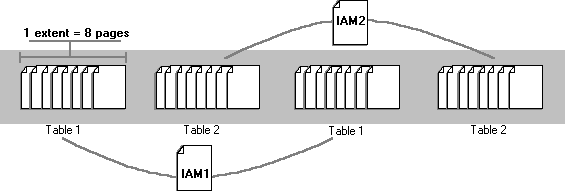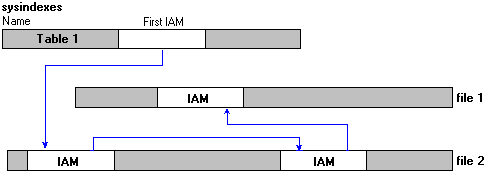Managing Space Used by Objects
Index Allocation Map (IAM) pages map the extents in a database file used by a heap or index. IAM pages also map the extents allocated to the ntext, text, and image page chain for any table that has columns of these types. Each of these objects has a chain of one or more IAM pages recording all the extents allocated to it. Each object has at least one IAM for each file on which it has extents. They may have more than one IAM on a file if the range of the extents on the file allocated to the object exceeds the range that an IAM can record.

IAM pages are allocated as needed for each object and are located randomly in the file. sysindexes.dbo.FirstIAM points to the first IAM page for an object, and all the IAM pages for that object are linked in a chain.

An IAM page has a header indicating the starting extent of the range of extents mapped by the IAM. The IAM also has a large bitmap in which each bit represents one extent. The first bit in the map represents the first extent in the range, the second bit represents the second extent, and so on. If a bit is 0, the extent it represents is not allocated to the object owning the IAM. If the bit is 1, the extent it represents is allocated to the object owning the IAM page.
When Microsoft® SQL Server™ 2000 needs to insert a new row and no space is available in the current page, it uses the IAM and PFS pages to find a page with enough space to hold the row. SQL Server uses the IAM pages to find the extents allocated to the object. For each extent, SQL Server searches the PFS pages to see if there is a page with enough free space to hold the row. Each IAM and PFS page covers a large number of data pages, so there are few IAM and PFS pages in a database. This means that the IAM and PFS pages are generally in memory in the SQL Server buffer pool, so they can be searched quickly.
SQL Server allocates a new extent to an object only when it cannot quickly find a page in an existing extent with enough space to hold the row being inserted. SQL Server allocates extents from those available in the filegroup using a proportional allocation algorithm. If a filegroup has two files, one of which has twice the free space of the other, two pages will be allocated from the file with more empty space for every one page allocated from the other file. This means that every file in a filegroup should have a similar percentage of space used.